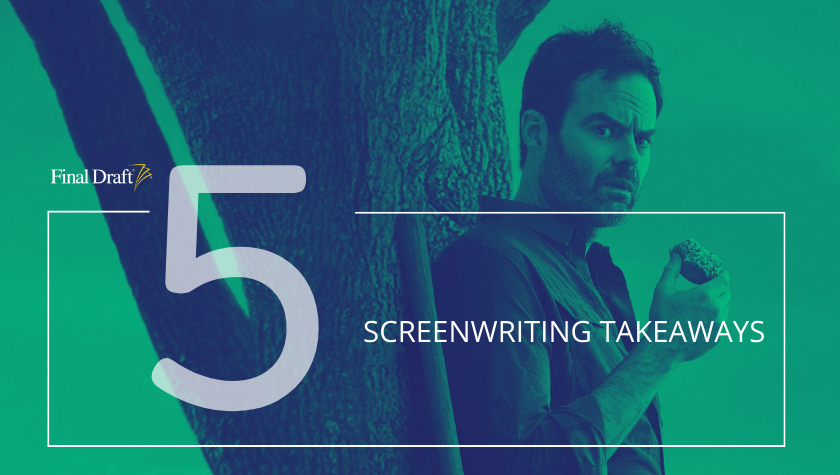All The Write Moves: 'Barry'
May 20, 2019
There’s a long history of merging comedy with violence, so it’s not as if the HBO series Barry, a dramedy about a hitman who discovers that he enjoys acting more than murder, is unprecedented. Counter-intuitive as it sounds, however, freshness isn’t necessarily a requirement for putting a high concept over. The trick is creating narrative unity — a compelling reason why the various elements of the concept have been combined. In the case of Barry, created by Alec Berg and Bill Hader (the latter of whom stars as the title character) what makes the premise work is that the hitman element provides danger while the acting element provides drama.
Specifically, when Barry Berkman (Hader) stumbles across an acting class while stalking a target, he discovers a way to express emotions that he has long suppressed throughout his criminal career and, before that, through military service. On a metaphorical level, the idea of pretending to be other people onstage resonates with Barry’s need to become a new person in real life. Thus, what could have been a cartoonish premise is actually somewhat profound — a meditation on the redemptive power of making art.
Given the thematic fuel driving Barry, it’s interesting to note that the show isn’t by any measure the outright comedy one might have expected from Hader, previously best known for his wild characters on Saturday Night Live. Instead, Barry is a showcase for Hader’s serious side, with just enough morbid humor to utilize his remarkable comic gifts.
Emotions in Motion
It’s worth drilling deeper into what makes the premise of Barry work, because in episode after episode, Berg and Hader (together with their adept writing staff) demonstrate why a strong premise is also, in screenwriting parlance, a “story engine.” As the terminology suggests, the guiding principle when constructing a story engine is to arrange a set of circumstances that can perpetually beget more circumstances.
For Barry, emotion is the key. At the moment Barry first discovers acting, he’s caught in an existential crisis, because he can no longer reconcile assassinations by convincing himself that his targets are villains who deserve to die. Barry’s malaise makes him both impressionable and vulnerable when he observes an acting class taught by Gene Cousineau (Henry Winkler). And here’s the kicker: The actual moment that makes Gene think Barry might have talent is a raw confession, rather than the improvisational exercise that Gene perceives it to be.
Like any good acting coach, Gene guides his students to mine their own emotions for raw material that can get channeled into performances — in practice for this particular set of wannabe actors, therapy masked by the ritual of pretending to be other people. It’s the perfect situation for Barry, who needs to exorcise demons, but cannot safely tell the truth about himself. The final layer that Berg and Hader include is that just as his peers don’t realize Barry is lying about his identity, Barry is too naïve about actors to read their “real” emotions correctly. In this way, learning the idiosyncratic, emotional languages of other people is a matter of life and death for everyone on Barry, even for characters so ignorant of Barry’s true nature that they have no reason to expect bodily peril.
Takeaway: A good story engine generates a myriad of narrative complications.
Trust Falls
One of the most enjoyably perverse aspects of Barry is the show’s depiction of trust as an unreliable aspect of life. This is baked into the essence of the series. Barry needs to trust his business representative, Monroe Fuches (Stephen Root), not only because Monroe is Barry’s source of employment, but also because every time Monroe sends Barry on a job, Barry risks capture or death. Similarly, the people in Gene’s acting class need to trust their scene partners, partially because one bad performance can tank an entire scene, and partially because actors feed off of the energy they receive from the players opposite them.
Accordingly, whenever a character on Barry betrays trust of any kind, the betrayal has massive repercussions. The push-and-pull between Barry and Monroe is a source of considerable drama, and so too is the turbulent dynamic between Barry and Sally Reed (Sarah Goldberg), a classmate and occasional lover. Yet these are just the most prominent examples of how important trust is to Barry. Sally also suffers whenever she puts undeserved faith in Hollywood professionals, such as a talent agent who subtly punishes her for refusing a sexual overture.
Talking about trust naturally leads back to the topic of Barry’s premise, because the theme of trust is inherently fused to the premise for the reasons stated above — an actor trusts other people at the risk of artistic failure, and an assassin trusts other people at the risk of something far worse. Furthermore, trust functions as a metaphor representing the larger topic of human connection. At the beginning of the series, Barry is the ultimate loner inasmuch as he treats other people as either obstacles or opportunities. He must join the human community in order to grow, but doing so brings unintended consequences — some terrible, some wonderful — for everyone he encounters. It’s the choice between observing life from a distance, and participating in it.
Takeaway: Fusing theme to premise adds depth to story beats.
Beyond Buffoonery
The aspect of Barry that drifts closest to the broad comedy one might have expected from Hader is the inclusion of several absurd, supporting characters. Gene, the acting coach, initially comes across as a self-involved hack who callously exploits desperate young people by charging steep rates for lessons. NoHo Hank (Anthony Carrigan), a low-level operative in a European crime syndicate, initially comes across as a nincompoop. Yet both characters reveal unexpected depth, thereby steering the show clear of presenting one-dimensional buffoons.
Among the best examples of how Berg, Hader, and their writing team complicate the portrayals of absurd supporting characters is a small season one scene featuring Gene. After we’ve watched several incidents of Gene arrogantly supervising his students, we observe Gene going to a pathetic audition for a walk-on role. He renders his audition with the utmost of professionalism, even though every bit of narrative context suggests he has zero chance of booking the gig. The next time we see Gene with his students, we view him differently — instead of arrogant, he seems wounded.
The writers take a different path with NoHo Hank, but one that’s just as effective. The character is connected to some of the best sight gags in season one, because he has a peculiar habit of adorning texts about horrific subjects with goofy memes. But toward the end of the season, when NoHo Hank encounters the scene of a mass murder, he doesn’t respond like an imbecile — quite to the contrary, he is calm and strategic. Together, these behavior patterns reveal a person who isn’t so much cavalier about violence, as he is inoculated against the shock of violence after a lifetime of exposure.
Takeaway: Revealing unexpected facets helps ground outrageous characters.
Written by: Peter Hanson
Peter Hanson is a Los Angeles-based writer, filmmaker and teacher. He directed the screenwriting documentary Tales from the Script, and he teaches at Pepperdine University and UCLA Extension. He provides script consulting at www.GrandRiverFilms.com.



